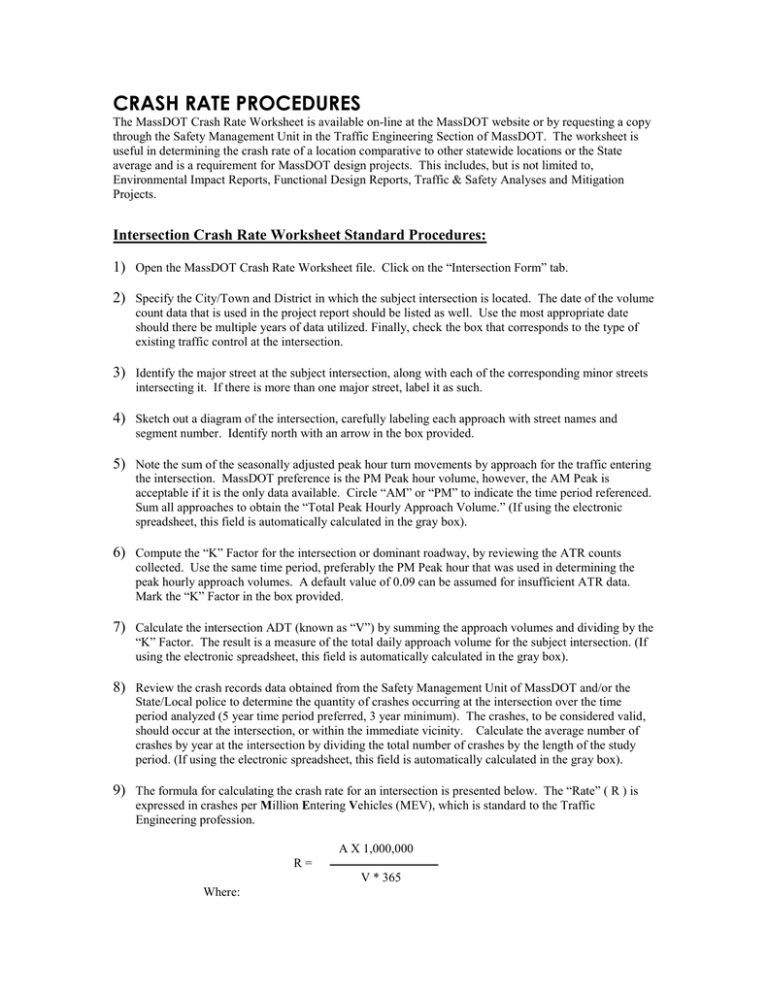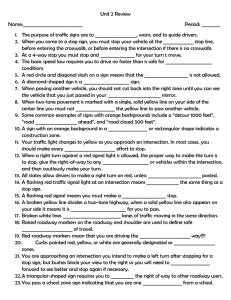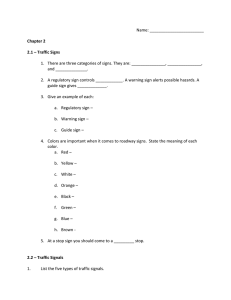CRASH RATE PROCEDURES
advertisement

CRASH RATE PROCEDURES The MassDOT Crash Rate Worksheet is available on-line at the MassDOT website or by requesting a copy through the Safety Management Unit in the Traffic Engineering Section of MassDOT. The worksheet is useful in determining the crash rate of a location comparative to other statewide locations or the State average and is a requirement for MassDOT design projects. This includes, but is not limited to, Environmental Impact Reports, Functional Design Reports, Traffic & Safety Analyses and Mitigation Projects. Intersection Crash Rate Worksheet Standard Procedures: 1) Open the MassDOT Crash Rate Worksheet file. Click on the “Intersection Form” tab. 2) Specify the City/Town and District in which the subject intersection is located. The date of the volume count data that is used in the project report should be listed as well. Use the most appropriate date should there be multiple years of data utilized. Finally, check the box that corresponds to the type of existing traffic control at the intersection. 3) Identify the major street at the subject intersection, along with each of the corresponding minor streets intersecting it. If there is more than one major street, label it as such. 4) Sketch out a diagram of the intersection, carefully labeling each approach with street names and segment number. Identify north with an arrow in the box provided. 5) Note the sum of the seasonally adjusted peak hour turn movements by approach for the traffic entering the intersection. MassDOT preference is the PM Peak hour volume, however, the AM Peak is acceptable if it is the only data available. Circle “AM” or “PM” to indicate the time period referenced. Sum all approaches to obtain the “Total Peak Hourly Approach Volume.” (If using the electronic spreadsheet, this field is automatically calculated in the gray box). 6) Compute the “K” Factor for the intersection or dominant roadway, by reviewing the ATR counts collected. Use the same time period, preferably the PM Peak hour that was used in determining the peak hourly approach volumes. A default value of 0.09 can be assumed for insufficient ATR data. Mark the “K” Factor in the box provided. 7) Calculate the intersection ADT (known as “V”) by summing the approach volumes and dividing by the “K” Factor. The result is a measure of the total daily approach volume for the subject intersection. (If using the electronic spreadsheet, this field is automatically calculated in the gray box). 8) Review the crash records data obtained from the Safety Management Unit of MassDOT and/or the State/Local police to determine the quantity of crashes occurring at the intersection over the time period analyzed (5 year time period preferred, 3 year minimum). The crashes, to be considered valid, should occur at the intersection, or within the immediate vicinity. Calculate the average number of crashes by year at the intersection by dividing the total number of crashes by the length of the study period. (If using the electronic spreadsheet, this field is automatically calculated in the gray box). 9) The formula for calculating the crash rate for an intersection is presented below. The “Rate” ( R ) is expressed in crashes per Million Entering Vehicles (MEV), which is standard to the Traffic Engineering profession. A X 1,000,000 R= V * 365 Where: A = Average number of crashes at the study location per year V = Intersection ADT (total daily approach volume) Roadway Segment Crash Rate Worksheet Standard Procedures: 1) Open the MassDOT Crash Rate Worksheet file. Click on the “Segment Form” tab. 2) Specify the City/Town(s) and District(s) in which the roadway is located. The date of the ATR count data that is used in the project report should be listed as well. Should there be multiple years of count data, use the most appropriate date. 3) Identify the roadway name as well as the start and end point of the roadway being analyzed (start and end points can be noted by cross streets or mile markers). Also identify the functional classification of the roadway. Complete additional crash rate worksheets for segments of the same roadway with different roadway characteristics, including but not limited to: functional classifications, land use, horizontal/vertical geometry, number of lanes, traffic volumes, crash patterns, etc. 4) Sketch a stick diagram of the roadway, carefully labeling the roadway and any cross streets with street names. Identify north with an arrow in the box provided. 5) Note the length of the segment (L) in terms of miles. 6) Note the average daily traffic volume (both directions) (V). 7) Review the crash records data obtained from the Safety Management Unit of MassDOT and/or the State/Local police to determine the quantity of crashes occurring along the roadway over the time period analyzed (5 year time period preferred, 3 year minimum) and enter this on the form. Enter in the total number of years analyzed. Calculate the average number of crashes along the segment by dividing the total number of crashes by the length of the study period in years (If using the electronic spreadsheet, this field is automatically calculated in the gray box). 8) The formula for calculating the crash rate for a roadway segment is presented below. The “Rate” ( R ) is expressed in crashes per Million Vehicle Miles Traveled (MVMT), which is standard to the Traffic Engineering profession. A X 1,000,000 R= L* V * 365 Where: A = Average number of crashes along the study roadway per year L = Length of roadway segment in miles V = Average Daily Traffic Volume along the roadway

